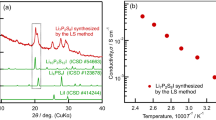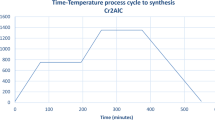Abstract
Co-P ribbons have been obtained by electrodeposition on aluminium substrates. The effect of changing the current density (in the range 8–19 A dm−2) and the H3PO3 concentration on the nature of the phases present in the “as-prepared” samples and their thermal evolution has been studied by X-ray diffraction analysis and differential scanning calorimetry. Amorphous and crystalline (fully or partly) products have been obtained, by changing the bath composition. Devitrification of the initially amorphous samples leads to cobalt (in the hexagonal and/or cubic form) and cobalt phosphide (Co2P) crystalline phases. A devitrification mechanism has been proposed. The presence of two amorphous phases in the glassy samples and the possibility of obtaining intermediate samples with crystalline and amorphous phases intermixed with each other, is suggested from the experimental results. The electrical resistivities of the products obtained have been measured. They are affected by the phosphorus content and develop after thermal treatments, in agreement with both microstructure changes and the nature of the crystalline cobalt phases formed.
Similar content being viewed by others
References
R. W. Cochrane andG. S. Cargill,Phys. Rev. Lett. 32 (1974) 476.
D. Pan andD. Turnbull,J. Appl. Phys. 45 (1974) 1406.
G. Diez andH. Destgen,J. Magn. Magn. Mater. 19 (1980) 157.
K. Huller andG. Diez,ibid. 50 (1985) 250.
J. M. Riveiro, G. Riveiro andM. C. Sancheztrujillo,ibid. 58 (1986) 235.
A. Brenner, “Electrodeposition of alloys”, Vol. 2 (Academic Press, London, New York, 1963) Ch. 35.
K. Huller, M. Sydow andG. Diez,J. Magn. Mater. 53 (1985) 269.
L. Lanotte, P. Matteazzi andV. Tagliaferri,Mater. Sci. Tech. 6 (1990)
T. Kemény andJ. Sestak. “Comparison of crystallization kinetics determined by isothermal and non-isothermal methods”, Budapest 1985.
P. H. Herman andA. Weidinger,Macromol. Chim. 44 (1961) 24.
A. Benedetti, G. Cocco, G. Fagherazzi, B. Locardi andS. Meriani,J. Mater. Sci. 18 (1983) 1039.
K. Masui, T. Yamada andY. Hisamatsu,J. Jpn Inst. Metals 44 (1980) 651.
L. Lanotte andC. Luponio,J. Magn. Magn. Mater. (1991) 2006.
P. Lamparter andS. Steeb.J. Non-Cryst. Solids 106 (1988) 137.
Author information
Authors and Affiliations
Rights and permissions
About this article
Cite this article
Branda, F., Lanotte, L., Costantini, A. et al. Thermal evolution of Co1−x-Px electrodeposited ribbons and its influence on the electrical resistivity. J Mater Sci 28, 1824–1828 (1993). https://doi.org/10.1007/BF00595752
Received:
Accepted:
Published:
Issue Date:
DOI: https://doi.org/10.1007/BF00595752




